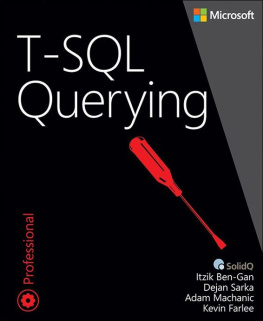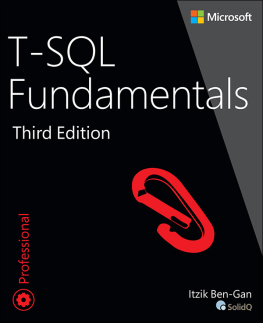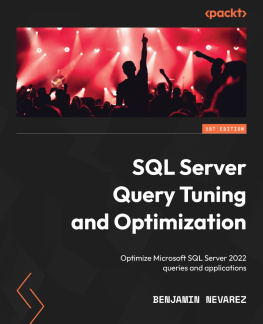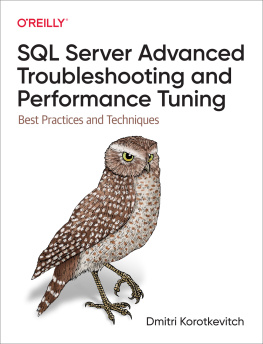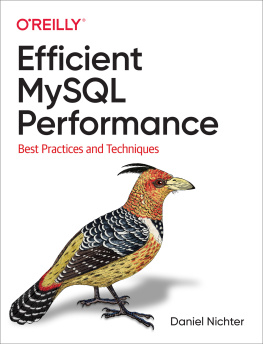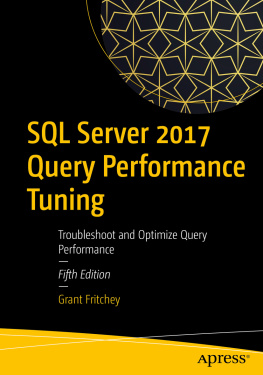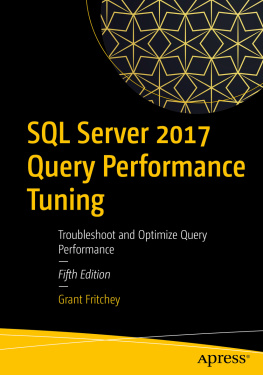T-SQL Querying
Itzik Ben-Gan
Dejan Sarka
Adam Machanic
Kevin Farlee

PUBLISHED BY
Microsoft Press
A Division of Microsoft Corporation
One Microsoft Way
Redmond, Washington 98052-6399
Copyright 2015 by Itzik Ben-Gan, Dejan Sarka, Adam Machanic, and Kevin Farlee. All rights reserved.
No part of the contents of this book may be reproduced or transmitted in any form or by any means without the written permission of the publisher.
Library of Congress Control Number: 2014951866
ISBN: 978-0-7356-8504-8
Printed and bound in the United States of America.
First Printing
Microsoft Press books are available through booksellers and distributors worldwide. If you need support related to this book, email Microsoft Press Support at .
This book is provided as-is and expresses the authors views and opinions. The views, opinions, and information expressed in this book, including URL and other Internet website references, may change without notice.
Some examples depicted herein are provided for illustration only and are fictitious. No real association or connection is intended or should be inferred.
Microsoft and the trademarks listed at http://www.microsoft.com on the Trademarks webpage are trademarks of the Microsoft group of companies. All other marks are the property of their respective owners.
Acquisitions Editor: Devon Musgrave
Developmental Editor: Devon Musgrave
Project Editor: Carol Dillingham
Editorial Production: Curtis Philips, Publishing.com
Technical Reviewer: Alejandro Mesa; Technical Review services provided by Content Master, a member of CM Group, Ltd.
Copyeditor: Roger LeBlanc
Proofreader: Andrea Fox
Indexer: William P. Meyers
Cover: Twist Creative Seattle and Joel Panchot
To Lilach, for giving meaning to everything that I do.
ITZIK
Contents at a glance
Contents
What do you think of this book? We want to hear from you!
Microsoft is interested in hearing your feedback so we can continually improve our books and learning resources for you To participate in a brief online survey, please visit:
microsoft.com/learning/booksurvey
Foreword
I have been with Microsoft and working with the Microsoft SQL Server team since 1993. It has been one heck of a ride to watch this product mature into what it is today. It has been exciting to watch how the Microsoft SQL Server customer base uses SQL Server to run their mission-critical businesses. Most of all, it has been an honor to support the most vibrant, passionate technology community I have ever seen.
The Microsoft SQL Server community is filled with truly amazing, smart people. They take pride in sharing their great knowledge with others, all for making the community stronger. Anyone in the world can jump on Twitter and ask any question to #sqlhelp, and within seconds one of the smartest experts in the world will be responding. If you are looking for expertise in performance, storage, query optimization, large-scale design, modeling, or any data-related topic, these experts are in the community today sharing their expertise. You will get to know them not only by their expertise but by their unique, friendly personalities as well. We in the SQL Server community world refer to this as our SQL family.
Everyone in the community knows the major contributors by their expertise in particular areas. If you ask who the best database performance expert is, people in the community will give you the same four or five names. If you ask for the best storage expert, again people will give you the same four or five storage expert names. Youll always find a few experts in the community who are the very best for a specific area of database domain expertise. There is only one exception to this that I am aware of, and that is the T-SQL language. There are a lot of talented T-SQL experts, but if you ask for the best everyone will give you one name: Itzik Ben-Gan.
Itzik asked me to write this foreword for his new book, and I am honored to do so. His previous booksInside Microsoft SQL Server: T-SQL Querying (Microsoft Press, 2009), Inside Microsoft SQL Server: T-SQL Programming (Microsoft Press, 2009), and Microsoft SQL Server High-Performance T-SQL Using Window Functions (Microsoft Press, 2012)are sitting on the shelves of every DBA I know. These books add up to over 2,000 pages of top-notch technical knowledge about Microsoft SQL Server T-SQL, and they set the standard for high-quality database content.
I am excited about this new book, T-SQL Querying. Not only does it combine material from his three previous books, but it also adds material from SQL Server 2012 and 2014, including window functions, the new cardinality estimator, sequences, columnstore, In-Memory OLTP, and much more. Itzik has a few exciting co-authors as well: Kevin Farlee, Adam Machanic, and Dejan Sarka. Kevin is part of the Microsoft SQL Server engineering team and someone I have been working with for many years. Adam is one of those few names that I refer to above as one of the best database performance experts in the world, and Dejan is well known for his BI and data-modeling expertise.
I fully expect this book to be the standard T-SQL guide for the Microsoft SQL Server community.
Mark Souza
General Manager, Cloud and Enterprise Engineering
Microsoft
Introduction
Updating both Inside Microsoft SQL Server 2008: T-SQL Querying (Microsoft Press, 2009) and parts of Inside Microsoft SQL Server 2008: T-SQL Programming (Microsoft Press, 2009), this book gives database developers and administrators a detailed look at the internal architecture of T-SQL and a comprehensive programming reference. It includes coverage of SQL Server 2012 and 2014, but in many cases deals with areas that are not version-specific and will likely be relevant in future versions of SQL Server. Tackle the toughest set-based querying and query-tuning problemsguided by an author team with in-depth, inside knowledge of T-SQL. Deepen your understanding of architecture and internalsand learn practical approaches and advanced techniques to optimize your codes performance. This book covers many unique techniques that were developed, improved, and polished by the authors over their many years of experience, providing highly efficient solutions for common challenges. Theres a deep focus on the performance and efficiency of the techniques and solutions covered. The book also emphasizes the need to have a correct understanding of the language and its underlying mathematical foundations.
Who should read this book
This book is designed to help experienced T-SQL practitioners become more knowledgeable and efficient in this field. The books target audience is T-SQL developers, DBAs, BI pros, data scientists, and anyone who is serious about T-SQL. Its main purpose is to prepare you for real-life needs, as far as T-SQL is concerned. Its main focus is not to help you pass certification exams. That said, it just so happens that the book covers many of the topics that exams 70-461 and 70-464 test you on. So, even though you shouldnt consider this book as the only learning tool to prepare for these exams, it is certainly a tool that will help you in this process.
Assumptions
This book assumes that you have at least a year of solid experience working with SQL Server, writing and tuning T-SQL code. It assumes that you have a good grasp of T-SQL coding and tuning fundamentals, and that you are ready to tackle more advanced challenges. This book could still be relevant to you if you have similar experience with a different database platform and its dialect of SQL, but actual knowledge and experience with SQL Server and T-SQL is preferred.

